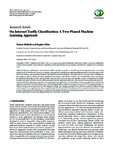On Internet Traffic Classification: A Two-Phased Machine Learning Approach
| dc.contributor.author | Bakhshi, T | |
| dc.contributor.author | Ghita, B | |
| dc.date.accessioned | 2016-09-09T08:28:00Z | |
| dc.date.accessioned | 2017-08-11T09:17:52Z | |
| dc.date.available | 2016-09-09T08:28:00Z | |
| dc.date.available | 2017-08-11T09:17:52Z | |
| dc.date.issued | 2016-07-01 | |
| dc.identifier.issn | 2090-7141 | |
| dc.identifier.issn | 2090-715X | |
| dc.identifier.other | 2048302 | |
| dc.identifier.uri | http://hdl.handle.net/10026.1/9762 | |
| dc.description.abstract |
<jats:p>Traffic classification utilizing flow measurement enables operators to perform essential network management. Flow accounting methods such as NetFlow are, however, considered inadequate for classification requiring additional packet-level information, host behaviour analysis, and specialized hardware limiting their practical adoption. This paper aims to overcome these challenges by proposing two-phased machine learning classification mechanism with NetFlow as input. The individual flow classes are derived per application through<mml:math xmlns:mml="http://www.w3.org/1998/Math/MathML" id="M1"><mml:mrow><mml:mi>k</mml:mi></mml:mrow></mml:math>-means and are further used to train a C5.0 decision tree classifier. As part of validation, the initial unsupervised phase used flow records of fifteen popular Internet applications that were collected and independently subjected to<mml:math xmlns:mml="http://www.w3.org/1998/Math/MathML" id="M2"><mml:mrow><mml:mi>k</mml:mi></mml:mrow></mml:math>-means clustering to determine unique flow classes generated per application. The derived flow classes were afterwards used to train and test a supervised C5.0 based decision tree. The resulting classifier reported an average accuracy of 92.37% on approximately 3.4 million test cases increasing to 96.67% with adaptive boosting. The classifier specificity factor which accounted for differentiating content specific from supplementary flows ranged between 98.37% and 99.57%. Furthermore, the computational performance and accuracy of the proposed methodology in comparison with similar machine learning techniques lead us to recommend its extension to other applications in achieving highly granular real-time traffic classification.</jats:p> | |
| dc.format.extent | 0-0 | |
| dc.language | en | |
| dc.language.iso | en | |
| dc.publisher | Hindawi Limited | |
| dc.relation.replaces | http://hdl.handle.net/10026.1/5424 | |
| dc.relation.replaces | 10026.1/5424 | |
| dc.title | On Internet Traffic Classification: A Two-Phased Machine Learning Approach | |
| dc.type | journal-article | |
| dc.type | Journal Article | |
| plymouth.volume | 2016 | |
| plymouth.publication-status | Published | |
| plymouth.journal | Journal of Computer Networks and Communications | |
| dc.identifier.doi | 10.1155/2016/2048302 | |
| plymouth.organisational-group | /Plymouth | |
| plymouth.organisational-group | /Plymouth/Faculty of Science and Engineering | |
| plymouth.organisational-group | /Plymouth/Faculty of Science and Engineering/School of Engineering, Computing and Mathematics | |
| plymouth.organisational-group | /Plymouth/REF 2021 Researchers by UoA | |
| plymouth.organisational-group | /Plymouth/REF 2021 Researchers by UoA/UoA11 Computer Science and Informatics | |
| plymouth.organisational-group | /Plymouth/Users by role | |
| plymouth.organisational-group | /Plymouth/Users by role/Academics | |
| dcterms.dateAccepted | 2016-05-08 | |
| dc.identifier.eissn | 2090-715X | |
| dc.rights.embargoperiod | Not known | |
| rioxxterms.versionofrecord | 10.1155/2016/2048302 | |
| rioxxterms.licenseref.uri | http://www.rioxx.net/licenses/all-rights-reserved | |
| rioxxterms.licenseref.startdate | 2016-07-01 | |
| rioxxterms.type | Journal Article/Review | |
| plymouth.oa-location | http://downloads.hindawi.com/journals/jcnc/2016/2048302.pdf |


